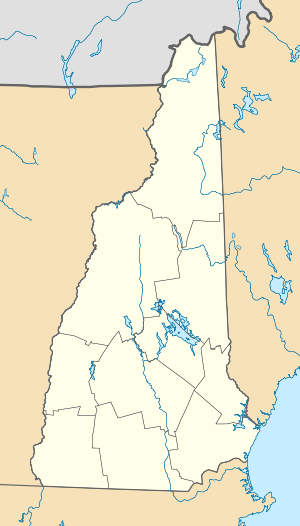Wentworth–Coolidge Mansion
|
Wentworth-Coolidge Mansion | |
|
The mansion in 2013 | |
  | |
| Nearest city | Portsmouth, New Hampshire |
|---|---|
| Coordinates | 43°3′42″N 70°44′20″W / 43.06167°N 70.73889°WCoordinates: 43°3′42″N 70°44′20″W / 43.06167°N 70.73889°W |
| Built | 1750 |
| Architect | unknown |
| Architectural style | Colonial |
| NRHP Reference # | 68000011 |
| Significant dates | |
| Added to NRHP | November 24, 1968[1] |
| Designated NHL | November 24, 1968[2] |
Wentworth–Coolidge Mansion is a 40-room clapboard house which was built as the home, offices and working farm of colonial Governor Benning Wentworth of New Hampshire. It is located on the water at 375 Little Harbor Road, about two miles southeast of the center of Portsmouth. It is one of the few royal governors' residences to survive almost unchanged. The site is a New Hampshire state park, declared a National Historic Landmark in 1968.[2][3] Today, the New Hampshire Bureau of Historic Sites manages the site with the assistance of the Wentworth-Coolidge Commission, a group of volunteer civic and business leaders appointed by the Governor.[4]
History of the house
In 1741, the governorship of the province of New Hampshire was separated from that of the Province of Massachusetts Bay, and Benning Wentworth, son of former Lieutenant-governor John Wentworth, was appointed its royal governor. He requested that the General Court erect a capitol in Portsmouth, but was refused. In 1750, Wentworth built his estate to include both a 100-acre (40 ha) working farm and council chamber.[5] The structure was made from existing buildings moved to the site and cobbled together with new sections, giving the house its eclectic appearance. From here Wentworth signed charters creating new towns across New Hampshire and Vermont.[6] The Cushing family acquired the property in 1816, and by the 1840s began showing the old mansion, one of America's first historic houses open to the public. Purchased with about 15 acres (6.1 ha) in 1886, John Templeman Coolidge III and his wife restored the mansion with the assistance of Sumner Appleton, founder of the Society for the Preservation of New England Antiquities. Coolidge was a Boston Brahmin, artist and antiquarian who used the property as a summer home. His guests included such luminaries as John Singer Sargent, Edmund C. Tarbell and Isabella Stewart Gardner.[7] Coolidge's widow, Mary Abigail Parsons Coolidge, donated the Wentworth–Coolidge Mansion to the state in 1954.[8]
Drift Contemporary Art Gallery
An Edwardian era barn on the historic site property was adapted in the late 1990s by the state as a suite for a visitor center, function rooms and offices. Starting around 2000, it was used in summer as a gallery of contemporary local art and in winter as an art school into the early 2000s. After the gallery manager retired and subsequently died, it sat idle until 2013, when the Drift Gallery moved from Kittery, Maine, to the space. It runs the gallery as a private entity in partnership with the mansion. The gallery has featured the works of many contemporary artists including Robert Wilson and Ryan Jude Novelline.[9] The gallery has also formed an educational component and is working on a weeklong, day residency as an homage to the late 19th-century artist colony established by John Templeton Coolidge.[10]
Gallery
- Council Chambers in the Wentworth mansion where Wentworth presided over provincial council meetings and where, in front of the fireplace, he married his second wife[11]
.jpg) The mansion c. 1901
The mansion c. 1901
See also
- National Register of Historic Places listings in Rockingham County, New Hampshire
- List of National Historic Landmarks in New Hampshire
References
- ↑ National Park Service (2007-01-23). "National Register Information System". National Register of Historic Places. National Park Service.
- 1 2 "Wentworth-Coolidge Mansion". National Historic Landmark summary listing. National Park Service. Retrieved 2007-10-21.
- ↑ Polly M. Rettig and Charles W. Snell (July 1975). "National Register of Historic Places Inventory-Nomination: Wentworth-Coolidge Mansion / Benning Wentworth Mansion" (pdf). National Park Service. and Accompanying 4 photos, exterior and interior, from 1975. (1.07 MB)
- ↑ http://wentworthcoolidge.org/?page_id=38
- ↑ British Governors Wentworth – Brewster's Rambles About Portsmouth #17
- ↑ New Hampshire Division of Parks & Recreation – Benning Wentworth
- ↑ New Hampshire Division of Parks & Recreation – Coolidge Center for the Arts
- ↑ New Hampshire Division of Parks & Recreation – John Templeman Coolidge III
- ↑ "Drift Gallery has the 'Last Word' — reception Sept. 28", Sea Coast Online, 9/26/2013
- ↑ Jeanné McCartin, "Gossip: Drift Gallery drifts to Wentworth-Coolidge Mansion", Sea Coast Online, 4/18/2013
- ↑ C.S. Gurney, Portsmouth, Historic and Picturesque, (1902), p. 98 at: https://archive.org/stream/portsmouthhistor00gurn#page/98/mode/2up
External links
| Wikimedia Commons has media related to Wentworth–Coolidge Mansion. |
- Wentworth-Coolidge Mansion Historic Site, New Hampshire Division of Parks & Recreation
- Wentworth-Coolidge Commission
- Drift Contemporary Art Gallery

